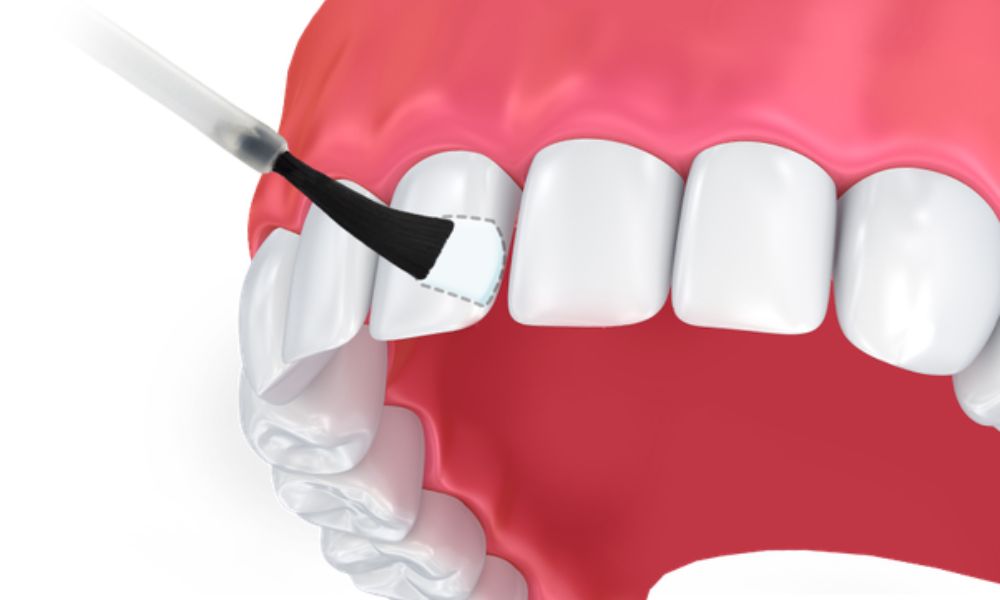Dental varnish is a protective coating applied to teeth to prevent decay, strengthen enamel, and reduce sensitivity. It is a clear, thin layer of material, usually containing fluoride, that is painted onto the teeth by a dental professional. Commonly used in the dental practice in Lawrenceville, GA by expert specialists, this protective coating offers numerous benefits for improved oral health. Let’s explore them further!
Types of dental varnish
There are several types of dental varnish, including:
- Fluoride varnish: Contains fluoride to strengthen enamel, prevent decay, and reduce sensitivity.
- Calcium phosphate varnish: Releases calcium and phosphate ions to remineralize teeth and promote healthy enamel.
- Nano-hydroxyapatite varnish: Contains nano-hydroxyapatite to remineralize, strengthen, and protect teeth.
- Chlorhexidine varnish: Contains chlorhexidine to reduce bacteria, prevent gingivitis, and promote gum health.
- Silver diamine fluoride (SDF) varnish: Contains silver and fluoride to prevent decay, reduce sensitivity, and promote tooth health.
- Potassium nitrate varnish: Contains potassium nitrate to reduce sensitivity and provide relief from hypersensitivity.
- Sodium fluoride varnish: Contains sodium fluoride to strengthen enamel, prevent decay, and reduce sensitivity.
- Acidulated phosphate fluoride (APF) varnish: Contains acidulated phosphate fluoride to strengthen enamel and prevent decay.
- Titanium dioxide varnish: Contains titanium dioxide to provide a physical barrier against bacteria and acid attacks.
- Bioactive Varnish: Contains bioactive ingredients like calcium, phosphate, and fluoride to promote tooth health and remineralization.
The application process for dental varnish
The application process for dental varnish typically involves the following steps:
- Teeth cleaning: The dentist or hygienist cleans the teeth to remove any plaque, bacteria, or debris.
- Isolation: The teeth are isolated with cotton rolls or a rubber dam to prevent saliva and moisture from interfering with the varnish.
- Etching (optional): The teeth may be etched with a mild acid to create a rough surface for better varnish adhesion.
- Varnish application: The dental varnish is applied to the teeth using a small brush. The varnish is usually painted onto the teeth in a thin layer.
- Setting: The varnish is allowed to set and harden on the teeth. This can take a few seconds to a minute, depending on the type of varnish.
Benefits of dental varnish

The benefits of dental varnish include:
- Cavity prevention: Dental varnish helps prevent tooth decay by creating a barrier against bacteria and acid attacks.
- Enamel strengthening: Fluoride in the varnish strengthens tooth enamel, making teeth more resistant to wear and tear.
- Sensitivity reduction: Varnish can reduce tooth sensitivity by blocking dentinal tubules and shielding nerves.
- Easy application: Dental varnish is quickly and easily applied, making it a convenient preventive measure.
- Painless: The application process is painless and doesn’t require anesthesia.
- Suitable for all ages: Dental varnish can be applied to teeth of all ages, from children to adults.
- Remineralization: Some varnishes contain calcium and phosphate to remineralize and strengthen teeth.
- Antibacterial properties: Some varnishes contain ingredients like chlorhexidine to reduce bacteria and prevent gingivitis.
- Desensitizing: Some varnishes contain ingredients like potassium nitrate to reduce sensitivity.
- Cost-effective: Dental varnish is a cost-effective preventive measure compared to restorative treatments.
- Non-invasive: The application process is non-invasive and doesn’t require drilling or injections.
- Quick results: Dental varnish provides quick results, with some varnishes showing effectiveness within minutes.
- Long-lasting: Some varnishes can last for several months, providing extended protection.
- Promotes good oral health: Dental varnish encourages good oral hygiene habits and regular dental check-ups.
- Reduces risk of tooth loss: By preventing decay and strengthening teeth, dental varnish reduces the risk of tooth loss.
Wrapping up
Dental varnish is a simple, effective way to protect teeth from decay, strengthen enamel, and reduce sensitivity. Its ease of application, painless process, and suitability for all ages make it an excellent preventive measure for maintaining good oral health. Regular applications can help ensure a healthy, cavity-free smile for years to come.










